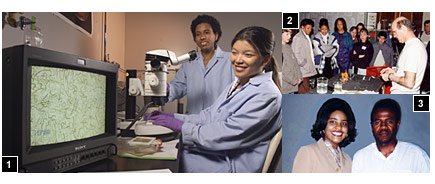|
|

|


|

What’s New?
Our new Eight Point Plan for NASA University (NASA
U) aims to expand education at NASA Ames from the original NASA Academy,
held each summer for the past seven years. We will preserve the outstanding aspects
of the Academy to date and expand NASA's leadership in astrobiology education
in the following ways:
Broadened Science and Technology Scope
NASA U addresses a key need for workforce development: identifying and
mentoring the leaders of tomorrow. Its new modular program aims to spur the exchange
of ideas to catalyze new science and engineering and better collaboration across
disciplines to meet the challenges of NASA Missions. An August
2003 Astrogram article describes how scientists and engineers at NASA Ames
pioneered a program visioning process that led to the conception of NASA U.
Augmented Program: Hub & Spokes
The Hub of NASA U serves a range of student programs that address astrobiology
questions at NASA. New modules to complement the present NASA Academy (leadership)
module involve a range of scientists working on NASA-related research and technology
development.
NASA U addresses all leading research disciplines that impact NASA Missions -
not only space science, life science, and earth science, but also nanotechnology
and information science and technology.
Annual Colloquium on Leading Edge Research at NASA
The 2003 Colloquium, held July 11, the Friday before Academy Alumni Weekend,
drew together NASA scientists, Academy Alumni, 2003 Academy Research Associates,
students from a range of other programs with astrobiology participants, and invited
external guests to envision astrobiology directions for the future. Distinguished
keynote speakers and Alumni gave presentations. The Colloquium was open to all
at NASA Ames, with seats reserved for Academy Research Associates, Alumni, and
Principal Investigators.
Collaborative Hub and Website
NASA U is committed to provide a coherent framework and resources to add value and enable better cross-disciplinary communication among astrobiology programs at NASA. Its website is evolving to support knowledge-sharing and better collaboration among these diverse programs.
Distributed Network of University Collaborators
NASA U collaborates with universities whose faculty and students conduct research on the many facets of astrobiology, one of the most cross-disciplinary scientific research disciplines. This distributed network grows and evolves year round. We have begun to identify courses
offered in astrobiology, both to provide this information to interested students, and to initiate knowledge-sharing among scientists teaching in this field.
Leadership
NASA U addresses NASA's need for two complementary types of leadership:
- Scientific — taking creative risks to achieve breakthrough scientific discoveries or develop new, innovative technology;
- Organizational — project management, leadership of people, vision in organizations.
Minority Talent
With advice from experts in this field, the NASA U has initiated an effort to recruit more outstanding minority candidates into its program.

1. Melissa Kirven-Brooks, research scientist with Lockheed Martin, working with a student. 2. Research Scientist Lou Allamandola with a group of students in his lab. 3. Research Scientist George Cooper: with Veda Bartlow, who won an award for her project.
|
Assessment
The NASA U hub supports ongoing Program Evaluation and Assessment. NASA U solicits your ideas toward continually evolving and improving its Program to meet the needs of NASA missions and of its university community.
The above Eight Point Plan extends the original Academy beyond its small, co-located team to involve a growing, distributed University Network of alumni, faculty, and students year round.
|
|

|

